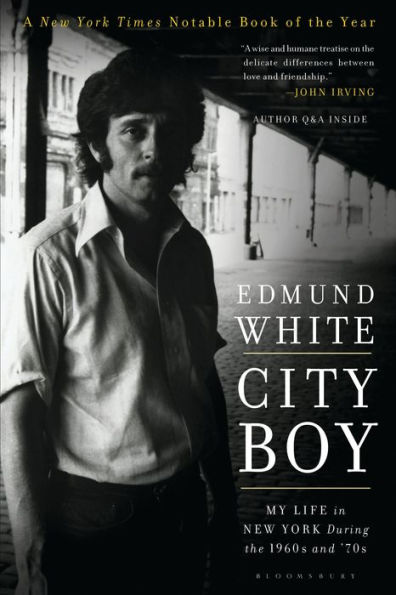

eBook
Related collections and offers
Overview

Product Details
| ISBN-13: | 9781608191543 |
|---|---|
| Publisher: | Bloomsbury Publishing |
| Publication date: | 10/07/2009 |
| Sold by: | Barnes & Noble |
| Format: | eBook |
| Pages: | 304 |
| File size: | 3 MB |
About the Author
Edmund White is the author of many novels, including A Boy's Own Story, The Beautiful Room Is Empty, The Farewell Symphony, and Our Young Man. His nonfiction includes City Boy, Inside a Pearl, The Unpunished Vice, and other memoirs; The Flâneur, about Paris; and literary biographies and essays. He was named the 2018 winner of the PEN/Saul Bellow Award for Achievement in American Fiction and received the 2019 Medal for Distinguished Contribution to American Letters from the National Book Foundation.
Edmund White is the author of many novels, including A Boy's Own Story, The Beautiful Room Is Empty, The Farewell Symphony, and A Previous Life. His nonfiction includes City Boy, Inside a Pearl, The Unpunished Vice, and other memoirs; The Flâneur, about Paris; and literary biographies and essays. He has received the PEN/Saul Bellow Award for Achievement in American Fiction and the Medal for Distinguished Contribution to American Letters from the National Book Foundation. He lives in New York.
Read an Excerpt
City Boy
My Life in New York During the 1960s and '70sBy Edmund White
Bloomsbury
Copyright © 2009 Edmund WhiteAll right reserved.
ISBN: 978-1-59691-402-5
Chapter One
In the 1970s in New York everyone slept till noon.It was a grungy, dangerous, bankrupt city without normal services most of the time. The garbage piled up and stank during long strikes of the sanitation workers. A major blackout led to days and days of looting. We gay guys wore whistles around our necks so we could summon help from other gay men when we were attacked on the streets by gangs living in the projects between Greenwich Village and the West Side leather bars.
The upside was that the city was inexpensive, and Manhattan, especially the part of it below Fourteenth Street, was full of young actors-singers-dancers-waiters who made enough money working their restaurant shifts three nights a week to pay for their acting lessons and their cheap rents. Unlike our hometowns back in the Midwest, where the sidewalk was rolled up at six p.m., the delis and coffee shops were open all night and the bars till four in the morning. That whole army of actor-waiters saw their restaurant jobs as just another opportunity for "scene study" ("Who am I tonight? An Austrian aristocrat who's fallen on bad times? A runaway from an incestuous family in the Tennessee Hills? A Swedish gymnast?"). No matter how big their tips were, they managed todrink them away in a bar after the restaurants closed as they talked excitedly about their art and their loves. Everyone smoked all the time, and when you French-kissed someone, it was like rubbing one ashtray against another.
New York seemed either frightening or risible to the rest of the nation. To us, however, it represented the only free port on the entire continent. Only in New York could we walk hand in hand with a member of the same sex. Only in New York could we ignore a rat galloping across our path and head out for a midnight play reading. Artists on the Lower East Side were recycling the most primitive and worthless materials-junk, really.
But there was also a mandarin New York, a place where painters and choreographers and novelists and poets strove to produce serious art of the highest order. This was an elite group of people, scattered throughout the Village and the emerging neighborhood of Chelsea and the comfortable, kicked-out Upper West Side; in this mandarinate artists and intellectuals still felt connected to the supreme artists of the past, still thought that their work would be the latest installment in a quasi-divine legacy.
I had constant daydreams of meeting Susan Sontag and Paul Goodman. I don't know why I focused on them-maybe because they were so often mentioned in the Village Voice and the Partisan Review but even by Time. He'd written Growing Up Absurd, the bible of the sixties, now largely forgotten (I never read it in any event). How could I have worshipped a man whose work I didn't know? I guess because I'd heard that he was bisexual, that he was a brilliant therapist, and that he was somehow for the young and the liberated. I read his astonishing journal, Five Years, published in 1966, a groundbreaking book in which he openly discussed paying men for sex and enjoying anonymous sex in the meatpacking district. Today that would seem unremarkable, perhaps, but for a husband and a father back then to be so confiding, so shameless, was unprecedented, especially since the sex passages were mixed in with remarks on culture and poetry and a hundred other subjects.
Sontag was someone I read more faithfully, especially Against Interpretation and even individual essays as they were published.
New York, in short, in the seventies was a junkyard with serious artistic aspirations. I remember that one of our friends, the poet Brad Gooch, wanted to introduce us to his lover, who'd become an up-and-coming Hollywood director, but Brad begged him not to tell us that he worked as a director since Hollywood had such low prestige among us. That sort of reticence would be unthinkable today in a New York that has become enslaved by wealth and glitz, but back then people still embraced Ezra Pound's motto, "Beauty is difficult."
We kept asking in 1972 and 1973 when the seventies were going to begin ...
Then again we had to admit the sixties hadn't really begun until the Beatles came over to the States in 1964, but after that the decade took on a real, definite personality-protest movements, long hair, love, drugs, a euphoria that turned sour only toward the end of 1969. Of course for Leftists the decade began with the Brown v. Board of Education decision and ended with Nixon's resignation in 1974.
I suppose people hadn't really thought each decade should have its own character and be different from the others till the 1920s, although I remember in a nineteenth-century Russian novel someone remarked that a character was a typical man of the 1830s-progressive and an atheist. But at that time it seemed more a question of generations-one belonged to the generation of "superfluous men," for instance, or one was a frivolous, self-indulgent product of the Belle Époque. But certainly in the 1920s, as the idea of the modern became current, every amateur sociologist began to seek out the personality of the dawning decade.
In retrospect we could see that the 1950s had been a reactionary period in America of Eisenhower blandness, of virulent anticommunism, of the Feminine Mystique. I lived through the fifties in the Midwest when everything that was happening-the repression of homosexuality, for instance, the demonization of the Left, the giggly, soporific ordinariness of adolescence, the stone deafness to the social injustice all around us-seemed not only unobjectionable but also nonexistent. Somehow we'd all been led to think that the order of things in the fifties was "natural," eternal and unchanging. The cult books of that epoch were The Lonely Crowd and The Man in the Gray Flannel Suit.
The great triumph of the sixties was to dramatize just how arbitrary and constructed the seeming normality of the fifties had been. We rose up from our maple-wood twin beds and fell onto the great squishy, heated water bed of the sixties.
At the end of the 1970s I wrote, "There was no style for the decade, no flair, no slogans. The mistake we made was that we were all looking for something as startling as the Beatles, acid, Pop Art, hippies and radical politics. What actually set in was a painful and unexpected working out of the terms the Sixties had so blithely tossed off."
(Continues...)
Excerpted from City Boy by Edmund White Copyright © 2009 by Edmund White. Excerpted by permission.
All rights reserved. No part of this excerpt may be reproduced or reprinted without permission in writing from the publisher.
Excerpts are provided by Dial-A-Book Inc. solely for the personal use of visitors to this web site.
